初一英语讲学稿(Unit 3)
- 格式:doc
- 大小:69.50 KB
- 文档页数:4
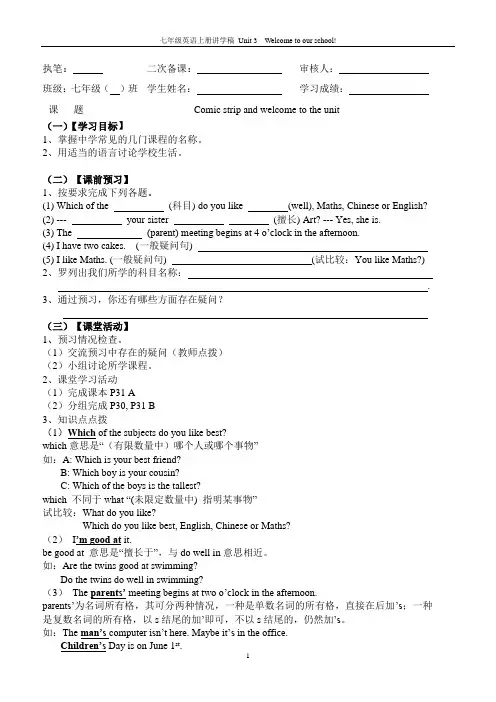
执笔:二次备课:审核人:班级:七年级()班学生姓名:学习成绩:课题Comic strip and welcome to the unit(一)【学习目标】1、掌握中学常见的几门课程的名称。
2、用适当的语言讨论学校生活。
(二)【课前预习】1、按要求完成下列各题。
(1) Which of the (科目) do you like (well), Maths, Chinese or English?(2) --- your sister (擅长) Art? --- Yes, she is.(3) The (parent) meeting begins at 4 o’clock in the afternoon.(4) I have two cakes. (一般疑问句)(5) I like Maths. (一般疑问句) (试比较:You like Maths?)2、罗列出我们所学的科目名称:.3、通过预习,你还有哪些方面存在疑问?(三)【课堂活动】1、预习情况检查。
(1)交流预习中存在的疑问(教师点拨)(2)小组讨论所学课程。
2、课堂学习活动(1)完成课本P31 A(2)分组完成P30, P31 B3、知识点点拨(1)Which of the subjects do you like best?which意思是“(有限数量中)哪个人或哪个事物”如:A: Which is your best friend?B: Which boy is your cousin?C: Which of the boys is the tallest?which 不同于what “(未限定数量中) 指明某事物”试比较:What do you like?Which do you like best, English, Chinese or Maths?(2)I’m good at it.be good at 意思是“擅长于”,与do well in意思相近。
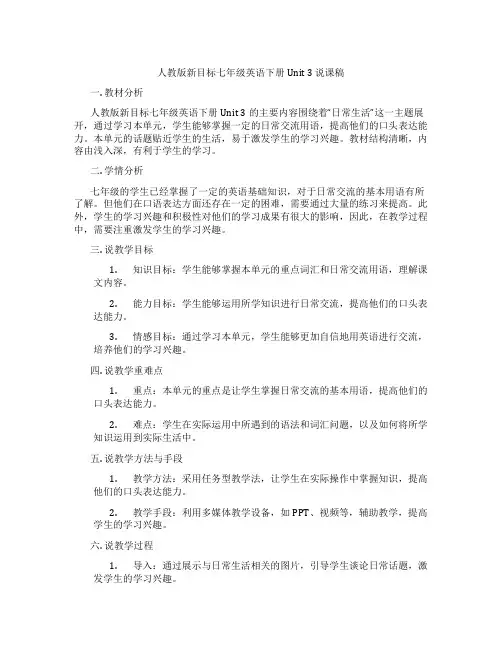
人教版新目标七年级英语下册 Unit 3 说课稿一. 教材分析人教版新目标七年级英语下册Unit 3的主要内容围绕着“日常生活”这一主题展开,通过学习本单元,学生能够掌握一定的日常交流用语,提高他们的口头表达能力。
本单元的话题贴近学生的生活,易于激发学生的学习兴趣。
教材结构清晰,内容由浅入深,有利于学生的学习。
二. 学情分析七年级的学生已经掌握了一定的英语基础知识,对于日常交流的基本用语有所了解。
但他们在口语表达方面还存在一定的困难,需要通过大量的练习来提高。
此外,学生的学习兴趣和积极性对他们的学习成果有很大的影响,因此,在教学过程中,需要注重激发学生的学习兴趣。
三. 说教学目标1.知识目标:学生能够掌握本单元的重点词汇和日常交流用语,理解课文内容。
2.能力目标:学生能够运用所学知识进行日常交流,提高他们的口头表达能力。
3.情感目标:通过学习本单元,学生能够更加自信地用英语进行交流,培养他们的学习兴趣。
四. 说教学重难点1.重点:本单元的重点是让学生掌握日常交流的基本用语,提高他们的口头表达能力。
2.难点:学生在实际运用中所遇到的语法和词汇问题,以及如何将所学知识运用到实际生活中。
五. 说教学方法与手段1.教学方法:采用任务型教学法,让学生在实际操作中掌握知识,提高他们的口头表达能力。
2.教学手段:利用多媒体教学设备,如PPT、视频等,辅助教学,提高学生的学习兴趣。
六. 说教学过程1.导入:通过展示与日常生活相关的图片,引导学生谈论日常话题,激发学生的学习兴趣。
2.新课呈现:讲解本节课的重点词汇和日常交流用语,让学生进行实际操作,如角色扮演等。
3.课堂练习:设计一些日常交流的场景,让学生进行实际运用,巩固所学知识。
4.课堂小结:对本节课的内容进行总结,让学生明确学习目标。
5.课后作业:布置一些与日常生活相关的任务,让学生课后进行练习,提高他们的口头表达能力。
七. 说板书设计板书设计要清晰、简洁,能够突出本节课的重点内容。
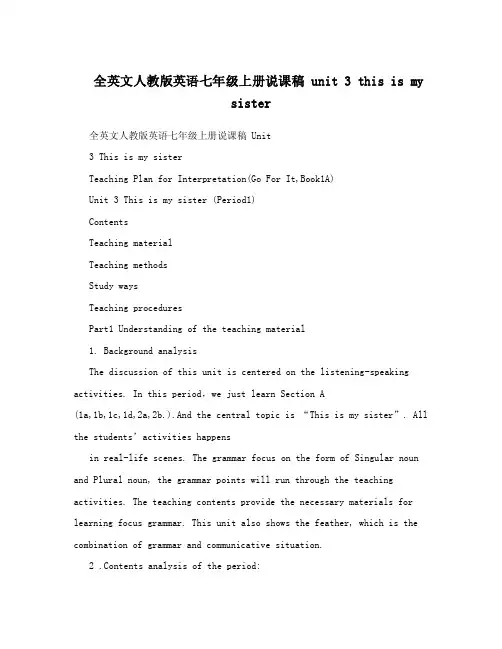
全英文人教版英语七年级上册说课稿 unit 3 this is mysister全英文人教版英语七年级上册说课稿 Unit3 This is my sisterTeaching Plan for Interpretation(Go For It,Book1A)Unit 3 This is my sister (Period1)ContentsTeaching materialTeaching methodsStudy waysTeaching proceduresPart1 Understanding of the teaching material1. Background analysisThe discussion of this unit is centered on the listening-speaking activities. In this period,we just learn Section A(1a,1b,1c,1d,2a,2b.).And the central topic is “This is my sister”. All the students’activities happensin real-life scenes. The grammar focus on the form of Singular noun and Plural noun, the grammar points will run through the teaching activities. The teaching contents provide the necessary materials for learning focus grammar. This unit also shows the feather, which is the combination of grammar and communicative situation.2 .Contents analysis of the period:The central topic is “Introducing and identifying people”,and the focusgrammar is the form of Singular noun and Plural noun, the verb “be” ,the relationships of these Pronouns(this、that、these、those), the teacherorganizes a series of activities, speaking, listening,practicing, whichrounds the central topic. All the activities is fit for New Curriculum of English. The designed activities are on the basis of “Socio-constructructivisit theory”.3 .Teaching arrangementWarm-up, listening, speaking.4.Teaching key pointsPlay a song as lead-in,which is to arouse students’ interest and attract their attention.Language practice and communicationA. Recognize the words of family membersB. Practice dialogue with classmates with the following sentence structures “This/That is my…,These are…Those are….”(Introducing people to others)C. Act out their dialogues to the whole class.5.Teaching difficult points: Introducing people(This/that is my… ),form of Singular noun and Plural noun.Teaching important point: To identify form of Singular noun andPlural noun, the relationships of these Pronouns(this、that、these、those).6. Teaching aids: tape recorder, tape, photos of family members.7. Teaching aims:By the end of the lesson,students will be able to:1)Knowledge aim :Learn and understand this new words:sister, mother, father, parent, brother, grandfather, grandmother, friend, these, are, those.Understand and use these sentence structures:Is this your sister, No,it isn’t.Is that your brother,Yes,it is.This is my friend. These are my friends.That is my brother. Those are his brothers.2) Ability aim:Introduce people and introduce people with these key sentence structures:“A. This is……, B. That is……,C. These are……,D. Those are…….”3)Emotional aim:Students will learn how to get well with others(suchfriends,classmates…)and how to be polite.Part 2 Teaching methods TBLTPart3 Studying ways1. Students learn some new words about family members,and how tointroduce people.2. Students learn how to use the new words and useful sentencestructure to practice the focus grammar exercise and make dialogues.3. Students are encouraged to communicate with others.Part 4 Teaching proceduresStep1.Warm- up:(3mins)1. Lead-in with a Chinese song .(《爸爸的爸爸叫什么》)2. Students should write down names of family members they’ve heardin the song in Chinese as much as possible. See who can write down the most names.The designed purpose:To motivate students’ interest in learningthislesson ,it is based on Gardner’s theory---“MultipleIntelligences”(especially the Musical-Rhythmic intelligence).Step2 Presentation (10mins)1.Show students a photo and then ask them some questions with the following sentences which they learned before.T:What is this in EnglishSs:It’s a photo.T : Is this your photo,Ss: No, it isn’t.T: It’s my photo.3. Teacher uses the photo to introduce his or her family members with the sentence structure “This is my…(new words: mother, sister, mother, father, parent, brother, grandfather, grandmother…)4.Learn new words.Teaching students new words with some relative photos and pictures. After that,students read the new words repeatedly(in the forms of the whole class,group by group,and in pair).5.Put the names of family members in a family tree.The designed purpose:Leading in by a photo,and learning new words with some photos,is to catch students’ attention,and the study way islively and effective.Step3 Practicing (7mins)1. Task1Students try to find these people in the picture(P13).Match the new words with people in the picture.2. Students try to introduce people with these sentence structures:This/That is my ...,These/Those are my…(Notice mistakes that students made, especially, the form of plural nouns.)The designed purpose:To make opportunity for students to practice the new words and new sentences more. Each student has chances to speak English.Step4 Listening and Practicing.(1b,1c) (9mins)1.Task2: Play the tape (1b) twice. At the first time, studentslisten and look at the picture; and at the second time, students circle the people the boy talks about. Then ask some students to read their answers.2.To choose some pairs to talk about Dave’s family.(with the followingsentence structures: This is his sister. These are hisbrothers…)Teacher should give some examples. And students imitate.3.Task3: Listening to part2 twice. At first,students listen and circle thenew words they hear; and then, students match the names with people in the picture. After that, pick some students to share their answers.4.Check the answers.The designed purpose:To chec k students’ understanding of the new words. See if they have got the meaning of the new words.Step5 Oral Practice (7mins)Task4?Students make a dialogue in pair with their photos with the key sentences structures.Ask two pairs to the platform to act out their dialogues.The designed purpose:The activity is to check students’ ability to usethe new sentence structures to make dialogue. And the students get the sense of success when they use English. It is also to check the teaching effect.Step6 (2mins)Make a conclusion to what have learned in this period: some vocabulary (sister, mother, father, parent, brother, grandfather, grandmother, friend…);some sentence structures: This is……,That is……,These are…… Those are…….The designed purpose: Stude nts can consolidate what’ve they learned in this period.Step7 Homework (2 mins)1. Recite and master the new words.2. After class, try to introduce your family members to your friends, orintroduce your friends family .The designed purpose: Students learn to communicate with others,theirlanguage knowledge will get improved.Layout:Unit 3 This is my sisterVocabulary: Sentence structures:sister, mother, Is this your sister, No,it isn’t.father, parent, Is that your brother,Yes,it is.brother, This is my friend. These are my friends.grandfather, That is my brother. Those are brothers.grandmother,friend, these,are, those.Part 5 CommentsTeacher designed three level questions for students(namely,they are for the excellent students,the general students,and the poor students instudy)so as to help each student get some knowledge from this period,to satisfy students’ needs, and makes they get the sense of success in English learning. In order to enliven the teaching class,teacher organizesrich activities for students to practice their language. In the process of teaching,teacher pays attention to students’ emotion so as to optimizetheir learning results, sometimes,it is necessary to changeteachingtechniques to attract students’ attention and improve the teaching efficiency.The song in my teaching plan is designed for the purpose of recognizing the names of family members,active thinking ways, and enables the students know family tree quickly, the song is also to arouse the students’ interest. Teaching new words of family members and the sentence structures is to make the students understand and learn how to introduce people to others. The moral education aims to teach students to be polite.Listening is to help the students identify family members and consolidate the new words.Practicing is a good way for students to master new words and master the key sentence structures.Dialogue Production is a solution to the problem of lacking chances to practice English outside class. This activity can train the students with this learning method. The teacher’s encouragement and facilitation arenecessary to make the students feel happiness of success.In general, the teaching tasks can be finished within this period, andmost of the students can understand the teaching points in this lesson.全英文人教版英语七年级上册说课稿 unit 3 this is my sister全英文人教版英语七年级上册说课稿 Unit3 This is my sisterTeaching Plan for Interpretation(Go For It,Book1A)Unit 3 This is my sister (Period1)ContentsTeaching materialTeaching methodsStudy waysTeaching proceduresPart1 Understanding of the teaching material1. Background analysisThe discussion of this unit is centered on the listening-speaking activities. In this period,we just learn Section A(1a,1b,1c,1d,2a,2b.).And the central topic is “This is my sister”. All the students’activities happensin real-life scenes. The grammar focus on the form of Singular noun and Plural noun, the grammar points will run through the teaching activities. The teaching contents provide the necessary materials for learning focus grammar. This unit also shows the feather, which is the combination of grammar and communicative situation.2 .Contents analysis of the period:The central topic is “Introducing and identifying people”,and the focusgrammar is the form of Singular noun and Plural noun, the verb“be” ,the relationships of these Pronouns(this、that、these、those), the teacherorganizes a series of activities, speaking, listening,practicing, which rounds the central topic. All the activities is fit for New Curriculumof English. The designed activities are on the basis of “Socio-constructructivisit theory”.3 .Teaching arrangementWarm-up, listening, speaking.4.Teaching key pointsPlay a song as lead-in,which is to arouse students’ interest and attract their attention.Language practice and communicationA. Recognize the words of family membersB. Practice dialogue with classmates with the following sentence structures “This/That is my…,These are…Those are….”(Introducing people to others)C. Act out their dialogues to the whole class.5.Teaching difficult points: Introducing people(This/that is my… ),form of Singular noun and Plural noun.Teaching important point: To identify form of Singular noun and Plural noun, the relationships of these Pronouns(this、that、these、those).6. Teaching aids: tape recorder, tape, photos of family members.7. Teaching aims:By the end of the lesson,students will be able to:1)Knowledge aim :Learn and understand this new words:sister, mother, father, parent, brother, grandfather, grandmother, friend, these, are, those. Understand and use these sentence structures:Is this your sister, No,it isn’t.Is that your brother,Yes,it is.This is my friend. These are my friends.That is my brother. Those are his brothers.2) Ability aim:Introduce people and introduce people with these key sentence structures:“A. This is……, B. That is……,C. These are……,D. Those are…….”3)Emotional aim:Students will learn how to get well with others(such friends,classmates…)and how to be polite.Part 2 Teaching methods TBLTPart3 Studying ways1. Students learn some new words about family members,and how to introduce people.2. Students learn how to use the new words and useful sentencestructure to practice the focus grammar exercise and make dialogues. 3. Students are encouraged to communicate with others.Part 4 Teaching proceduresStep1.Warm- up:(3mins)1. Lead-in with a Chinese song .(《爸爸的爸爸叫什么》)2. Students shou ld write down names of family members they’ve heardin the song in Chinese as much as possible. See who can write down the most names.The designed purpose:To motivate students’ interest in learning this lesson ,it is based on Gardner’s theory---“Multiple Intelligences”(especially the Musical-Rhythmic intelligence).Step2 Presentation (10mins)1.Show students a photo and then ask them some questions with the following sentences which they learned before.T:What is this in EnglishSs:It’s a photo.T : Is this your photo,Ss: No, it isn’t.T: It’s my photo.3. Teacher uses the photo to introduce his or her family members with the sentence structure “This is my…(new words: mother, sister, mother, father, parent, brother, grandfather, grandmother…)4.Learn new words.Teaching students new words with some relative photos and pictures.After that,students read the new words repeatedly(in the forms of the whole class,group by group,and in pair).5.Put the names of family members in a family tree.The designed purpose:Leading in by a photo,and learning new wordswith some photos,is to catch students’ attention,and the study way is lively and effective.Step3 Practicing (7mins)1. Task1Students try to find these people in the picture(P13).Match the newwords with people in the picture.2. Students try to introduce people with these sentence structures:This/That is my ...,These/Those are my…(Notice mistakes that students made, especially, the form of plural nouns.)The designed purpose:To make opportunity for students to practice thenew words and new sentences more. Each student has chances to speak English.Step4 Listening and Practicing.(1b,1c) (9mins)1.Task2: Play the tape (1b) twice. At the first time, students listenand look at the picture; and at the second time, students circle the people the boy talks about. Then ask some students to read their answers.2.To choose some pairs to talk about Dave’s family.(with the following sentence structures: This is his sister. These are hisbrot hers…)Teacher should give some examples. And students imitate.3.Task3: Listening to part2 twice. At first,students listen and circle thenew words they hear; and then, students match the names with people inthe picture. After that, pick some students to share their answers.4.Check the answers.The designed purpose:To check students’ understanding of the newwords. See if they have got the meaning of the new words.Step5 Oral Practice (7mins)Task4?Students make a dialogue in pair with their photos with the key sentences structures.Ask two pairs to the platform to act out their dialogues.The designed purpose:The activity is to check students’ ability to use the new sentence structures to make dialogue. And the students get the sense of success when they use English. It is also to check the teaching effect.Step6 (2mins)Make a conclusion to what have learned in this period: some vocabulary (sister, mother, father, parent, brother, grandfather, grandmother, friend…);some sentence structures: This is……,Thatis……,These are…… Those are…….The designed purpose: Students can consolidate what’ve they learnedin this period.Step7 Homework (2 mins)1. Recite and master the new words.2. After class, try to introduce your family members to your friends, or introduce your friends family .The designed purpose: Students learn to communicate with others, their language knowledge will get improved.Layout:Unit 3 This is my sisterVocabulary: Sentence structures:sister, mother, Is this your sister, No,it isn’t.father, parent, Is that your brother,Yes,it is.brother, This is my friend. These are my friends.grandfather, That is my brother. Those are brothers.grandmother,friend, these,are, those.Part 5 CommentsTeacher designed three level questions for students(namely,they arefor the excellent students,the general students,and the poor studentsinstudy)so as to help each student get some knowledge from this period,to satisfy students’ needs, and makes they get the sense of succ ess in English learning. In order to enliven the teaching class,teacher organizesrich activities for students to practice their language. In the processof teaching,teacher pays attention to students’ emotion so as to optimizetheir learning results, sometimes,it is necessary to change teaching techniques to attract students’ attention and improve the teaching efficiency.The song in my teaching plan is designed for the purpose of recognizing the names of family members,active thinking ways, andenables the students know family tree quickly, the song is also toarouse the students’ interest. Teaching new words of family members and the sentence structures is to make the students understand and learn how to introduce people to others. The moral education aims to teachstudents to be polite.Listening is to help the students identify family members andconsolidate the new words.Practicing is a good way for students to master new words and master the key sentence structures.Dialogue Production is a solution to the problem of lacking chances to practice English outside class. This activity can train the students with this learning method. The teacher’s encouragement and facilitation arenecessary to make the students feel happiness of success.In general, the teaching tasks can be finished within this period, and most of the students can understand the teaching points in this lesson.。
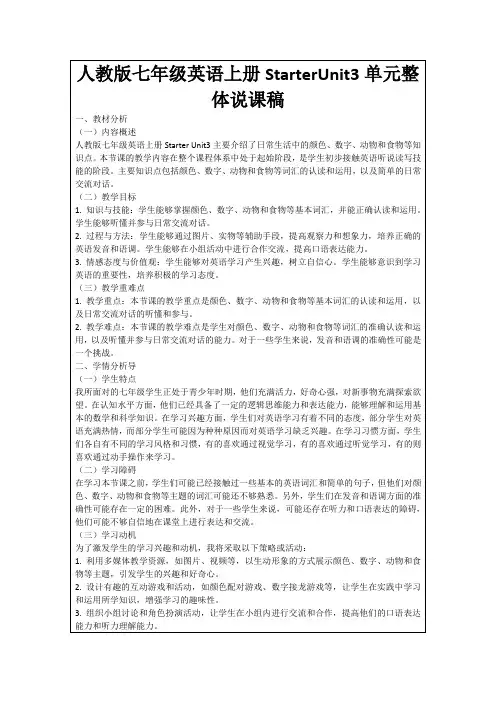
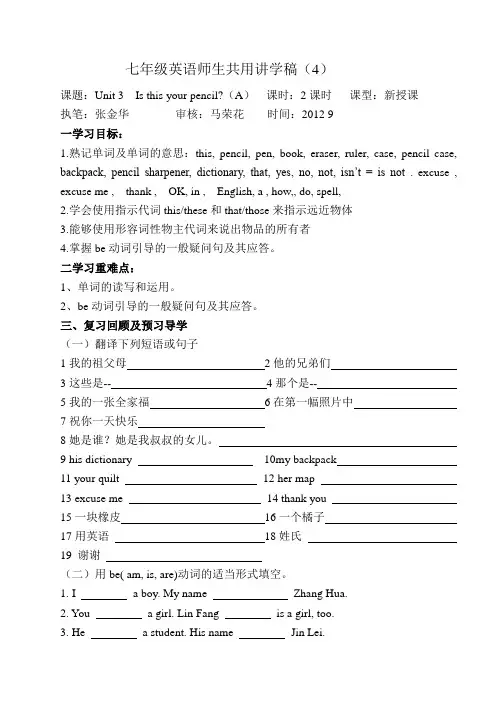
七年级英语师生共用讲学稿(4)课题:Unit 3 Is this your pencil?(A)课时:2课时课型:新授课执笔:张金华审核:马荣花时间:2012 9一学习目标:1.熟记单词及单词的意思:this, pencil, pen, book, eraser, ruler, case, pencil case, backpack, pencil sharpener, dictionary, that, yes, no, not, isn’t = is not . excuse , excuse me , thank , OK, in , English, a , how,, do, spell,2.学会使用指示代词this/these和that/those来指示远近物体3.能够使用形容词性物主代词来说出物品的所有者4.掌握be动词引导的一般疑问句及其应答。
二学习重难点:1、单词的读写和运用。
2、be动词引导的一般疑问句及其应答。
三、复习回顾及预习导学(一)翻译下列短语或句子1我的祖父母2他的兄弟们3这些是-- 4那个是--5我的一张全家福6在第一幅照片中7祝你一天快乐8她是谁?她是我叔叔的女儿。
9 his dictionary 10my backpack11 your quilt 12 her map13 excuse me 14 thank you15一块橡皮16一个橘子17用英语18姓氏19 谢谢(二)用be( am, is, are)动词的适当形式填空。
1. I a boy. My name Zhang Hua.2. Y ou a girl. Lin Fang is a girl, too.3. He a student. His name Jin Lei.4. —What this ? —It a bird.5. —you Grace? —No, I’m not. I’m Helen.6.How your mother?(三)用英语写出下列物品的名称;①书②钢笔③尺子④背包⑤文具盒⑥字典⑦橡皮⑧卷笔刀四、难点解析(一)辨析this/these与that/those四者都可以作指示代词,this/these指的是离说话者较近的人和物,而that/those 指的是离说话者在空间或时间上较远的人或者事物。
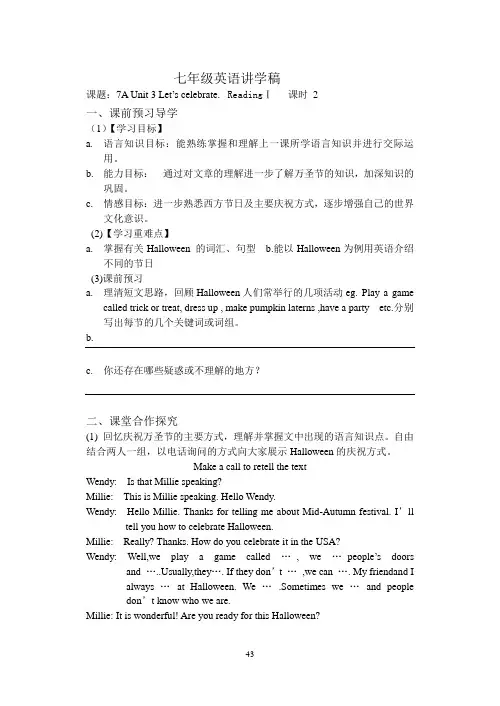
七年级英语讲学稿课题:7A Unit 3 Let’s celebrate. ReadingⅠ课时2一、课前预习导学(1)【学习目标】a.语言知识目标:能熟练掌握和理解上一课所学语言知识并进行交际运用。
b.能力目标:通过对文章的理解进一步了解万圣节的知识,加深知识的巩固。
c.情感目标:进一步熟悉西方节日及主要庆祝方式,逐步增强自己的世界文化意识。
(2)【学习重难点】a.掌握有关Halloween 的词汇、句型b.能以Halloween为例用英语介绍不同的节日(3)课前预习a.理清短文思路,回顾Halloween人们常举行的几项活动eg. Play a gamecalled trick or treat, dress up , make pumpkin laterns ,have a party etc.分别写出每节的几个关键词或词组。
b.c.你还存在哪些疑惑或不理解的地方?二、课堂合作探究(1)回忆庆祝万圣节的主要方式,理解并掌握文中出现的语言知识点。
自由结合两人一组,以电话询问的方式向大家展示Halloween的庆祝方式。
Make a call to retell the textWendy: Is that Millie speaking?Millie: This is Millie speaking. Hello Wendy.Wendy: Hello Millie. Thanks for telling me about Mid-Autumn festival. I’ll tell you how to celebrate Halloween.Millie: Really? Thanks. How do you celebrate it in the USA?Wendy: Well,we play a game called …, we …people’s doors and …ually,they…. If they don’t …,we can …. My friendand Ialways …at Halloween. We ….Sometimes we …and peopledon’t know who we are.Millie: It is wonderful! Are you ready for this Halloween?Wendy: Yes. I will wear …. We…for Halloween. We …the eyes, the nose and the sharp teeth.Millie: That sounds great! What about your family?Wendy: My family always …on the evening of October 31st. We don’t …and we …. Would you like join us that time?Millie: Really? Great! Thank you! See you then.Wendy: OK! See you!(2)重、难点解决1). We play a game called “trick or treat”Called “被叫着…;被称为…” =nameda. 一个叫Simon 的男孩 a boy ______(call) Simonb. Do you know the dog ________(name) Hobo?2) give sb. sth. = give sth to sb. 意思是“给某人某物”He gives us a big pumpkin. = He gives a big pumpkin to us.Can you give me some candies?=Can you give some candies to us ?3)a . thank sb. for 译为“因为…而感谢某人”Thank you for the beautiful flowers.Thank you for your birthday present.b. Thank sb./ Thanks for doing sth.Thanks for your help. Thanks for __________(help) me .Thank you for ________(invite)me to your party .三、课内练习巩固1) 谢谢你帮我学习英语。
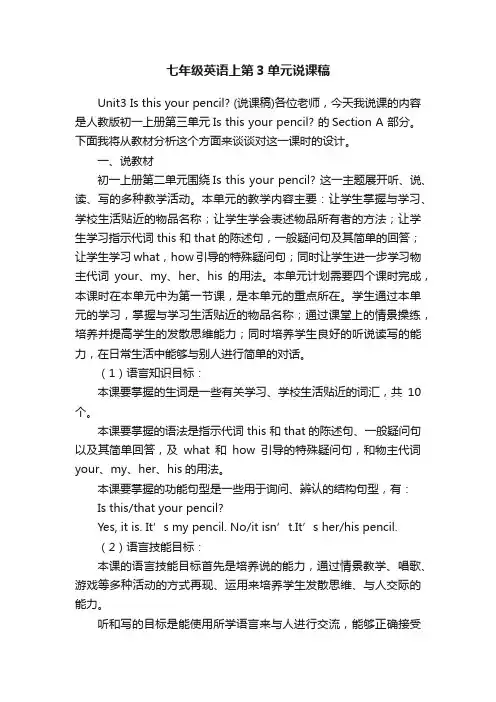
七年级英语上第3单元说课稿Unit3 Is this your pencil? (说课稿)各位老师,今天我说课的内容是人教版初一上册第三单元Is this your pencil? 的Section A 部分。
下面我将从教材分析这个方面来谈谈对这一课时的设计。
一、说教材初一上册第二单元围绕Is this your pencil? 这一主题展开听、说、读、写的多种教学活动。
本单元的教学内容主要:让学生掌握与学习、学校生活贴近的物品名称;让学生学会表述物品所有者的方法;让学生学习指示代词this和that的陈述句,一般疑问句及其简单的回答;让学生学习what,how引导的特殊疑问句;同时让学生进一步学习物主代词your、my、her、his的用法。
本单元计划需要四个课时完成,本课时在本单元中为第一节课,是本单元的重点所在。
学生通过本单元的学习,掌握与学习生活贴近的物品名称;通过课堂上的情景操练,培养并提高学生的发散思维能力;同时培养学生良好的听说读写的能力,在日常生活中能够与别人进行简单的对话。
(1)语言知识目标:本课要掌握的生词是一些有关学习、学校生活贴近的词汇,共10个。
本课要掌握的语法是指示代词this和that的陈述句、一般疑问句以及其简单回答,及what和how引导的特殊疑问句,和物主代词your、my、her、his的用法。
本课要掌握的功能句型是一些用于询问、辨认的结构句型,有:Is this/that your pencil?Yes, it is. It’s my pencil. No/it isn’t.It’s her/his pencil.(2)语言技能目标:本课的语言技能目标首先是培养说的能力,通过情景教学、唱歌、游戏等多种活动的方式再现、运用来培养学生发散思维、与人交际的能力。
听和写的目标是能使用所学语言来与人进行交流,能够正确接受对方的语言信息。
(3)学习策略目标:学习策略是指学生为了有效地学习和发展而采取的各种行动和步骤。
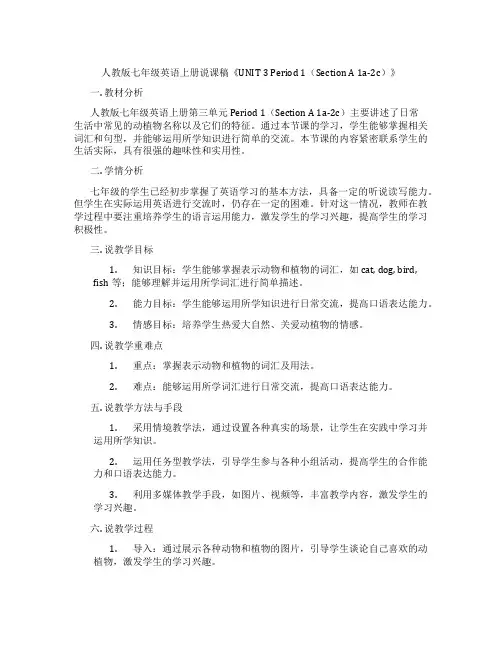
人教版七年级英语上册说课稿《UNIT 3 Period 1(Section A 1a-2c)》一. 教材分析人教版七年级英语上册第三单元Period 1(Section A 1a-2c)主要讲述了日常生活中常见的动植物名称以及它们的特征。
通过本节课的学习,学生能够掌握相关词汇和句型,并能够运用所学知识进行简单的交流。
本节课的内容紧密联系学生的生活实际,具有很强的趣味性和实用性。
二. 学情分析七年级的学生已经初步掌握了英语学习的基本方法,具备一定的听说读写能力。
但学生在实际运用英语进行交流时,仍存在一定的困难。
针对这一情况,教师在教学过程中要注重培养学生的语言运用能力,激发学生的学习兴趣,提高学生的学习积极性。
三. 说教学目标1.知识目标:学生能够掌握表示动物和植物的词汇,如cat, dog, bird,fish等;能够理解并运用所学词汇进行简单描述。
2.能力目标:学生能够运用所学知识进行日常交流,提高口语表达能力。
3.情感目标:培养学生热爱大自然、关爱动植物的情感。
四. 说教学重难点1.重点:掌握表示动物和植物的词汇及用法。
2.难点:能够运用所学词汇进行日常交流,提高口语表达能力。
五. 说教学方法与手段1.采用情境教学法,通过设置各种真实的场景,让学生在实践中学习并运用所学知识。
2.运用任务型教学法,引导学生参与各种小组活动,提高学生的合作能力和口语表达能力。
3.利用多媒体教学手段,如图片、视频等,丰富教学内容,激发学生的学习兴趣。
六. 说教学过程1.导入:通过展示各种动物和植物的图片,引导学生谈论自己喜欢的动植物,激发学生的学习兴趣。
2.新课呈现:教师展示Section A 1a-1c的图片,引导学生观察并说出所看到的动物和植物名称。
3.单词学习:教师讲解单词的读音、书写和用法,学生跟读并模仿。
4.句型练习:教师创设各种情境,让学生运用所学词汇和句型进行口语练习。
5.小组活动:学生分组进行角色扮演,运用所学知识进行对话表演。
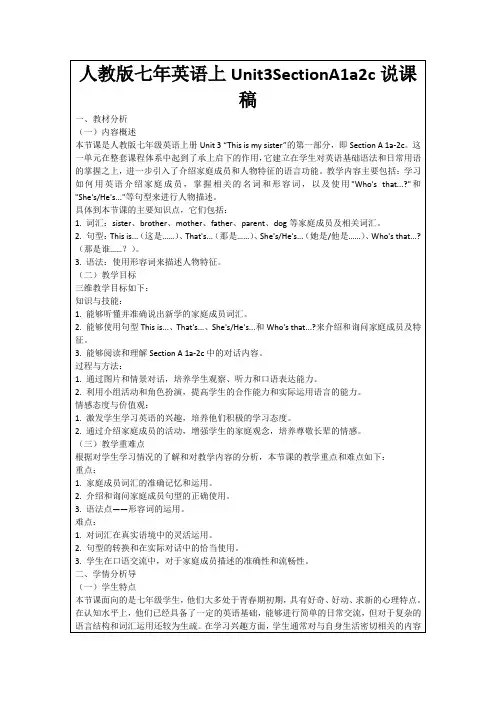
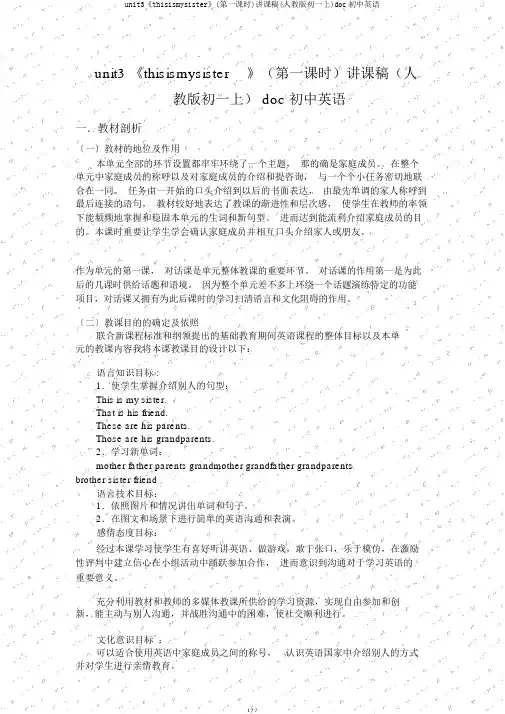
unit3 《thisismysister》(第一课时)讲课稿(人教版初一上) doc 初中英语一.教材剖析〔一〕教材的地位及作用本单元全部的环节设置都牢牢环绕了一个主题,那的确是家庭成员。
在整个单元中家庭成员的称呼以及对家庭成员的介绍和提咨询,与一个个小任务密切地联合在一同。
任务由一开始的口头介绍到以后的书面表达,由最先单调的家人称呼到最后连接的语句,教材较好地表达了教课的渐进性和层次感,使学生在教师的率领下能频频地掌握和稳固本单元的生词和新句型。
进而达到能流利介绍家庭成员的目的。
本课时重要让学生学会确认家庭成员并相互口头介绍家人或朋友。
作为单元的第一课,对话课是单元整体教课的重要环节。
对话课的作用第一是为此后的几课时供给话题和语境。
因为整个单元差不多上环绕一个话题演练特定的功能项目,对话课又拥有为此后课时的学习扫清语言和文化阻碍的作用。
〔二〕教课目的的确定及依照联合新课程标准和纲领提出的基础教育期间英语课程的整体目标以及本单元的教课内容我将本课教课目的设计以下:语言知识目标 :1.使学生掌握介绍别人的句型:This is my sister.That is his friend.These are his parents.Those are his grandparents.2.学习新单词:mother father parents grandmother grandfather grandparentsbrother sister friend语言技术目标:1.依照图片和情况讲出单词和句子。
2.在图文和场景下进行简单的英语沟通和表演。
感情态度目标:经过本课学习使学生有喜好听讲英语、做游戏,敢于张口,乐于模仿,在激励性评判中建立信心在小组活动中踊跃参加合作,进而意识到沟通对于学习英语的重要意义。
充分利用教材和教师的多媒体教课所供给的学习资源,实现自由参加和创新,能主动与别人沟通,并战胜沟通中的困难,使社交顺利进行。
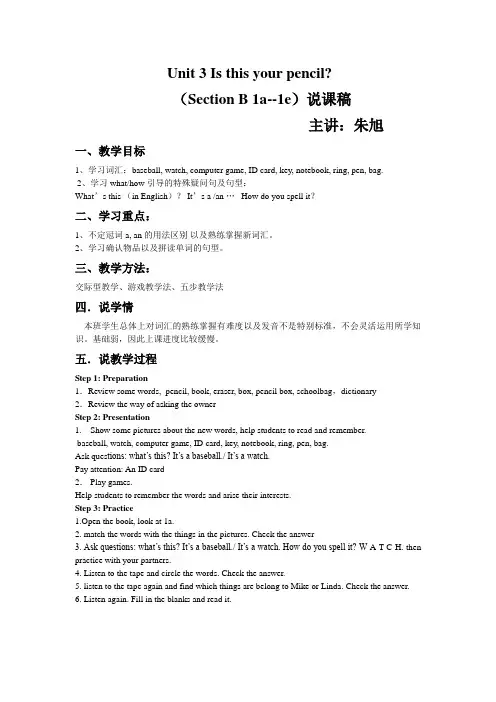
Unit 3 Is this your pencil?(Section B 1a--1e)说课稿主讲:朱旭一、教学目标1、学习词汇:baseball, watch, computer game, ID card, key, notebook, ring, pen, bag.2、学习what/how 引导的特殊疑问句及句型:What’s this (in English)? It’s a /an … How do you spell it?二、学习重点:1、不定冠词a, an 的用法区别以及熟练掌握新词汇。
2、学习确认物品以及拼读单词的句型。
三、教学方法:交际型教学、游戏教学法、五步教学法四.说学情本班学生总体上对词汇的熟练掌握有难度以及发音不是特别标准,不会灵活运用所学知识。
基础弱,因此上课进度比较缓慢。
五.说教学过程Step 1: Preparation1.Review some words, pencil, book, eraser, box, pencil box, schoolbag,dictionary 2.Review the way of asking the ownerStep 2: Presentation1. Show some pictures about the new words, help students to read and remember.baseball, watch, computer game, ID card, key, notebook, ring, pen, bag.Ask ques tions: what’s this? It’s a baseball./ It’s a watch.Pay attention: An ID card2. Play games.Help students to remember the words and arise their interests.Step 3: Practice1.Open the book, look at 1a.2. match the words with the things in the pictures. Check the answer3. Ask questions: what’s this? It’s a baseball./ It’s a watch. How do you spell it? W-A-T-C-H. then practice with your partners.4. Listen to the tape and circle the words. Check the answer.5. listen to the tape again and find which things are belong to Mike or Linda. Check the answer.6. Listen again. Fill in the blanks and read it.Step 4: Progress1.Role-play the conversations about the things in the chart. Then change roles.2.finish the exercise and check answer.Step:5 production1.finish the exercise and check answer.2. Homework1.1a单词一个抄写3遍,中文一遍。
人教版新目标七年级英语下册 Unit 3说课稿一. 教材分析人教版新目标七年级英语下册Unit 3的主要内容包括:课本上的对话和课文,以及相关的词汇、语法和练习。
本节课的主要话题是谈论日常生活,通过学习本节课,学生可以掌握一些与日常生活相关的词汇和表达方式,以及一般过去时的用法。
二. 学情分析七年级的学生已经掌握了基本的英语语法和词汇,但他们的英语听说能力还不够强。
因此,在教学过程中,我们需要注重培养学生的听说能力,让他们能够在实际生活中运用英语。
三. 说教学目标1.知识目标:学生能够掌握日常生活中常用的词汇和表达方式,理解并运用一般过去时。
2.能力目标:学生能够听懂、会说日常生活中的对话,提高他们的听说能力。
3.情感目标:通过学习本节课,学生能够激发对英语学习的兴趣,培养积极的学习态度。
四. 说教学重难点1.教学重点:学生能够掌握日常生活中常用的词汇和表达方式,理解并运用一般过去时。
2.教学难点:学生能够听懂、会说日常生活中的对话,并能够在实际生活中运用。
五. 说教学方法与手段1.教学方法:采用任务型教学法,让学生在实际操作中学习英语,提高他们的实践能力。
2.教学手段:利用多媒体课件、图片、卡片等辅助教学,激发学生的学习兴趣。
六. 说教学过程1.导入:通过与日常生活相关的话题引入本节课,激发学生的学习兴趣。
2.新课呈现:通过展示图片、多媒体课件等方式,展示本节课的主要内容,让学生初步感知。
3.讲解与练习:讲解日常生活中常用的词汇和表达方式,并通过练习让学生巩固所学知识。
4.对话练习:分组进行对话练习,让学生在实际操作中学会运用英语。
5.课堂小结:对本节课的主要内容进行总结,让学生明确所学知识。
七. 说板书设计板书设计要简洁明了,能够突出本节课的主要内容。
可以设计成思维导图的形式,将日常生活中常用的词汇和表达方式以及一般过去时的用法进行板书。
八. 说教学评价教学评价可以通过学生的课堂表现、作业完成情况和对话练习来进行。
新目标英语七年级上册Unit3 SectionA说课稿今天我说课的题目是新目标英语七年级上册第三单元Unit3 Is this your pencil? 中的SectionA(1a—2c)部分,整个说课我将分成六个大部分进行讲述:即教材分析、学情分析、教法、学法、教学过程及板书设计。
第一板块:教材分析(一)、说教材本课是新目标英语七年级上册第三单元第一课时,教材以Is this your pencil?为中心话题,围绕着谈论有关学习用品等与我们学习生活息息相关的物品,在对话中学生的取材也较为容易。
(二)、教学目标1.知识目标:a)学习单词: pen pencil eraser ruler dictionary schoolbag等b)学习并掌握句型:Is this your …? Are these/those…?Yes, it is. It’s mine. Yes, they are.No, it isn’t. /It’s…No, they aren’t.2.能力目标:通过情景对话、游戏及题目的训练,使学生学会根据场景就学习用品询问物主,并正确运用对应的英语表达方式。
通过听力及上下文来培养学生基本的逻辑思维能力及听音辨词的基本功。
3.情感目标:通过询问、辨认物主,倡导学生要保管好自己的学习用品。
(三)、教学重难点1. 重点;学习重点单词,句型和语法点:2. 难点:名词性物主代词以及形容词性物主代词的用法。
第二板块:学情分析七年级的学生有较高的求知欲和表现欲,希望自己的表现能得到同学和老师的认可。
且该阶段学生已具备初步的语言表达能力和较强的记忆力与模拟能力。
对他们所熟悉的话题学生的爱好会更浓,而本单元的话题正符合这一特点,所以我就设计任务型的课堂活动,让学生人人参与,增强他们学习的积极性和学习的自信心。
第三板块:说教法在教学中,要注意发挥学生的主体作用,把空间留给学生。
抓住初中生活泼好动,表现欲强的心理特点,课堂上我设计了大量听、说、读、写的训练,启发学生动脑思考,鼓励学生大胆开口,畅所欲言,尽可能运用英语表达实际意义,从而最大限度地调动学生的积极性和主动性。
第3单元How do you get to school?类别课程标准要求掌握的内容话题Transportation交通方式Section A 单词train n.火车 bus n.公共汽车 subway n.地铁ride v.骑n.旅程 bike n.自行车 sixty num.六十seventy num.七十 eighty num.八十 ninety num.九十hundred num.一百 minute n.分钟 far adv.& adj.远;远的kilometer(=kilometre)(abbr.km)n.千米;公里new adj.新的;刚出现的 every adj.每一;每个by prep.(表示方式)乘(交通工具) drive v.开车car n.小汽车;轿车 live v.居住;生活短语get to到达 take the subway 乘地铁 ride a bike 骑自行车every day每天 by bike骑自行车from home to school 从家到学校 how far 多远句型1.—How do you get to school? 你怎样去上学?—I ride my bike.我骑自行车。
2.—How long does it take to get to school?去学校要多长时间?—It takes about 15 minutes. 大约15分钟。
3.—How far is it from your home to school? 从你家到学校有多远?—It’s only about two kilometers.大约只有2 千米。
4.Have a good day at school.祝你在校过得愉快。
5.Does Jane walk to school?简步行去学校吗?Section B 单词stop n.车站;停止 cross v.横过;越过 river n.河;江many adj.& pron.许多 village n.村庄;村镇between prep.介于……之间bridge n.桥 boat n.小船 year n.年;岁afraid adj.害怕;畏惧 like prep.像;怎么样 villager n.村民leave v.离开;留下 dream n.梦想;睡梦v.做梦true adj.真的;符合事实的 ropeway n.索道短语think of 认为;想起between…and… 在……和……之间come true 实现;成为现实 have to 不得不;必须句型1.Mary wants to know what he thinks of the trip.玛丽想知道他认为这次旅行怎么样。
Unit 9 How was your weekend?课型:新授主备:焦纪霞审核:谢瑾时间06.6班级姓名Period 1(SectionA:1a—2b)[学习目标] 1. 熟记本课的新词汇。
2. 了解并学习一般过去时。
3. 掌握动词过去式的构成规则。
[课前准备]1. 预习并完成1a.2.请翻译下面六句话并比较:(!).I often do my homework at night.(2).I did my homework last night .(3).We often play soccer on weekends.(4).We played soccerlast weekend.(5).Lucy always cleans her room on Sundays.(6).Lucy cleaned her room last Sunday.通过翻译,可以看出例(1)、(3)、(5)用的是时态,表示、的。
而例(2)、(4)、(6)所发生的时间都与有关,表示的是。
因此可以看出这三句用的是时态。
3. 看例并参照课本101页总结动词过去式的构成规则。
(1)规则动词:eg:look—looked live—lived stop—stopped study—studiedA.B.C.D.由此可知,规则动词的过去式就是在动词后面加ed。
(2)不规则动词:(请熟记下面这些常见的不规则动词的过去式)am /is---was are---were do---did go---wenthave /has---had read---read see---saw run---rancome---came put---put write---wrote take---tookget---get4、请你探索:What did you do last weekend, Lucy? 本句是由引出的特殊疑问句,其中did是的。
在此做词,用于询问发生的动作或事情,而do在此为词,意思是。
5、预习自测:请你写出下列动词的过去式:play--- clean--- go--- come---run--- do --- study---- are---watch--- practice---【学习过程】1、师生互动,完成1a。
2、生生互动,结对练习1c中的对话内容。
3、听录音,完成课本上的1b、2a和2b。
4、语法要点梳理:一般过去时(1)概念:一般过去时表示某个时间发生的或存在的,也可以表示过去经常或反复发生的动作,常和表示过去的时间状语连用,如:yesterday; last +时间名词;数词+时间名词+ago;in+年份等,eg: I got up at 6:30 yesterday.(2)构成:A . be型:肯定句:主语+was /were+其他否定句:主语+wasn’t/wern’t+其他一般疑问句:Was/Were+主语+其他回答:Yes,主语+ was/were. /No,主语+ wasn’t/weren’t.eg:I was a student last year. We were happy last week.注意:was/were 的用法区别。
B. do型:肯定句:主语+动词过去式+其他否定句:主语+didn’t+动词原形+其他一般疑问句:Did+主语+动词原形+其他回答:Yes,主语+did. /No,主语+didn’t.注意:在do型中,一般过去时的否定句和疑问句必须借助于助动词did来完成,did没有人称的变化,当句中有助动词did时,动词必须用原形。
eg: I watched Tv last night.→I didn’t watch Tv last night.—Did you watch Tv last night?—Yes,I did./No,I didn’t.请翻译:张明上周末踢足球了。
【课后检测】1.He in the school play last week.A. isB. wasC. amD. be2.We to the beaches yesterday afternoon.A. goB. goesC. wentD. going3.She play the guitar well at the last concert.A. notB. isn’tC. doesn’tD. didn’t4.—Did you watch Tv last night?—I went to see the movie.A. Yes, I didB. Yes, I didn’tC. No, I didD. No, I didn’t5.On Saturday, I Tennis but I didn’t play baseball.A. playB. playedC. to playD. playingPeriod 2(SectionA:2c—3b)【学习目标】1、掌握并运用一般过去时。
2、学会询问“某人的周末过得怎么样”这一交际用语。
3、熟记Grammar Focus部分.【课前准备】1、预习并完成2c。
2、请翻译下列短语:visit a person--- go to a place--- stay at home---have a party--- do some reading--- practice English---study for the…test--- clean one’s room---3、看例探索:(1)What about your friend,Carol? What about going to the park?How about your friend,Carol? How about going to the park?句中What about…?=?用来表示或,意思是,其中about是词,后接词或。
请翻译:去游泳怎么样?。
(2)How was your weekend,Ming? 意思是?由此可以看出:How+be+…?意为“……怎么样?”,可与What+be+…+like?互换。
how表示“,”,用于询问、、状况等。
eg: How do you go to school? (方式)How is your mother?(状况)请总结对于How+be+…?问句的答语:①②③④4、预习自测:单选(1)--Where did you go last night? --I to Lily’s home.A. goB. wentC. will goD. goes(2).--- Lucy’s weekend? It was great.A. How wasB. What wasC. How isD. What is(3)We English yesterday.A. studyB. studysC. studyedD. studied(4)I don’t play basketball,I play violin.A. the,theB. a,theC. the,/D. /,the(5)He said he did homework.A .he B. he’s C. his D. him【学习过程】1、生生互动,结对练习2c对话,并分角色表演。
2、翻译并朗读Grammar Focus中的句子,体会一般过去时的用法。
3、师生互动,完成3a对话,并熟记对话内容,学会“How was your weekend?”句型及答语。
4、师生共究:do some reading意为“”,其结构为“”,意思是“”,表示跟这个动词-ing有关的某一具体的行为动作,类似的还有;do some washing 洗衣服do some cooking 烹饪do some shopping 购物do some cleaning 打扫do some sewing 缝衣服5、比一比,分组练习3b,就明、托尼和萨拉的周末进行问答练习,看看哪组做得好。
6、兴趣延伸:同学们,相信你们上周末一定过得很好吧?请你们根据3a对话内容,结对练习你们上周末的情况,好吗?【课后检测】1、根据汉语提示完成句子。
(1)She went to the beach. (你呢)?(2)I (打)soccer last Saturday.(3)Wang Ping (看望)her grandmother yesterday afternoon.(4)Amy (做)her homework last afternoon.(5)I enjoyed myself very much at the (聚会)(6)The students (去爬山)yesterday.(7)We (举行晚会)last night.(8)He (练习)English last weekend.2、用所给单词的适当形式填空。
(1)They did (they)homework at school.(2)“Let’s go(climb)the mountain.”“It’s a good idea.”(3)My mother often does some (wash)on weekends.(4)Who (cook)lunch for you yesterday?(5)I have much monkey.It’s about 2,000(dollar)(6)Carol (get)up at 6:00 every morning.period 3(SectionB 1a —3a)【学习目标】1、熟记本课的新词汇,掌握spend的用法。
2、通过阅读含有一般过去时的文章、短文,深刻体会、理解并熟练掌握动词的过去式的构成和英语习惯表达法。
3、通过本单元所学的语言点,熟练掌握并运用一般过去时态。
【课前准备1、预习并完成1a和2b 2、熟读3a短文,回答下列问题。
(1)Which school students were asked yesterday ?(2)How was the weekend for most students?(3)What did the ten students do on Saturday?(4)Did seven kids watch TV at home?(5)Did seven lids play sports on Sunday?3、预习自测:用课文中所出现的单词完成句子。
(1)How did you s your weekend?(2)I often see talk s on Thursday evening.(3)My mother v my grandmother yesterday.(4)He went to the movie.What a you?(5)How w your weekend?(6)Sally p the guitar this morning.(7)My weekend was f .I went to the beach.(8)On last Sunday night I was w TV.(9)Tom s geography last night.(10)I played basketball on Saturday m .【学习过程】1、师生互动,完成1a、1b。